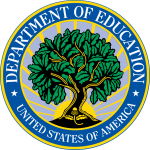In my prior post, I began to outline the potential impact of President Trump’s still forming education team and agenda. It is critical to remember that as he fills his Cabinet positions and defines his relationship with the Republican-controlled Congress, our ability to more accurately make predictions will increase. None of this can or will happen in a bubble, and whether it is through Democratic minority resistance, or even in-party ideological conflict, most proposals will likely encounter some degree of resistance.
Scenario One: Radical and Possible – But Unlikely in its Entirety
The Trump Administration decides to implement one statement made by Candidate Trump, and attempts to eliminate the Department of Education, entirely, and redirect as much funding to families in the form of vouchers that can be spent on public or private institutions. Emboldened by control of all three branches of government, lawmakers pursue their most ambitious plans to decrease the federal role in – and support for – public education.
Although this would be a difficult task to execute for a complex host of reasons, there are Republican lawmakers who have championed the idea, and have long sought to put money in the hands of families to spend as they’d like, wherever they would like, believing that competition would dramatically improve education for all. So, in concept, there is some appeal in Washington, and some far right-wing lawmakers would love to see this occur. That said, the entanglements between a host of federal legislations, beyond even the Every Student Succeeds Act, would make it particularly challenging and would require cooperation not seen in DC since the Washington Senators won the World Series in 1924.
A more plausible scenario would be an attempt to pursue Title One portability, which would put somewhere in the area of 20 billion dollars worth of funding in the hands of school choice and voucher programs. This would be money that typically went to school districts to support the district-wide needs.
What would this mean to your local schools? It depends on what you consider your “local school.” If it is a private institution, it’s potentially wonderful news for your pocketbook. Charter? It means little, although this could be debated in terms of ripple effects and the flooding of the market. For a majority of school districts, however, any redirection of federal funding would simply be devastating. In Arizona, the impact would be even more significant, as we consistently rate at, or near the bottom, of school funding per pupil, and Arizona schools rely on those dollars for everything from teacher training, to intervention services and tutoring. And yes, this is with recent funding increases included. Further, although the concept of vouchers that parents can cash in where they choose is appealing in concept, such uncertainty would make fiscal planning an impossibility for highly-regulated school districts who cannot budget the same way as a private business. This would likely force dramatic cutbacks in services and staffing, because schools must budget conservatively and cannot assume enrollment without cause or reason. To school districts, like the stock market, uncertainty is the ultimate enemy when trying to plan high-quality learning environments for students.
Although the public may not perceive enrollment uncertainty as a serious threat to public education, consider what one large school district in the state is currently facing. Although they have tens of thousands of students overall, enrollment, to date, is down over several hundred students. All told, this has led to a 2.5 million dollar hole in the budget. Although an assessment of why this drop has occurred is still ongoing, a large proportion of it appears to be due to private and charter draws. One might reasonably assume that the schools who suffered the most precipitous drops in enrollment were underperforming, and thus earned a decrease.
However, his has not proven true. There appears to be no correlation between their academic performance and the enrollment drop, with several of the impacted schools ranking, by every measure, as some of the top performing in the state – even outperforming a majority of the attractive private and charter options. Obviously, this makes determining how to retain students in a climate where families are often on the lookout for promises of something better - but maybe aren’t sure what better actually looks like – extremely difficult.
I will move on to other potential scenarios in my next post, however, the one described above explains why your local education officials are even more nervous than usual and in need a reassuring hug.
And in Arizona, we’re already perpetually nervous. If this plays out as described, my advice would be to invest in Xanax stock.
Or, better yet, open a charter or private school.
In my next post, I will tackle “Likely and Very Possible Changes.” I’ll bet you can’t wait…










Comments 2
This is great Mike. I really hope stakeholders take a look at what education leaders (dare I say experts) like yourself are realistically looking at in the future of education in the US. I appreciate your realistic stance on the current issues and the way in which you are looking at the impacts these will have on Arizona schools. While I will hold off on the purchase of Xanax stock, I may start looking a little bit closer at who is in the running for important staffing jobs under the next administration and make sure I am communicating with policy makers in Arizona about what students and educators need.
I’m so glad you’ve mentioned the important fact that some of the top public forms are loosing students without necessarily showing a drop in performance. The data showing the benefits of charter schools can be so misleading. While their holistic standardized test scores are higher, few charter schools have been able to demonstrate significant achievement improvement as part of their competition with public schools. That is to say, which the school’s passage numbers are higher, individual students do not show significant leaps and bounds in their own progress. This means the data is showing these schools simply have a higher number of high-performing students. Put another way, charter schools are successful recruiters, but not necessarily reformers.